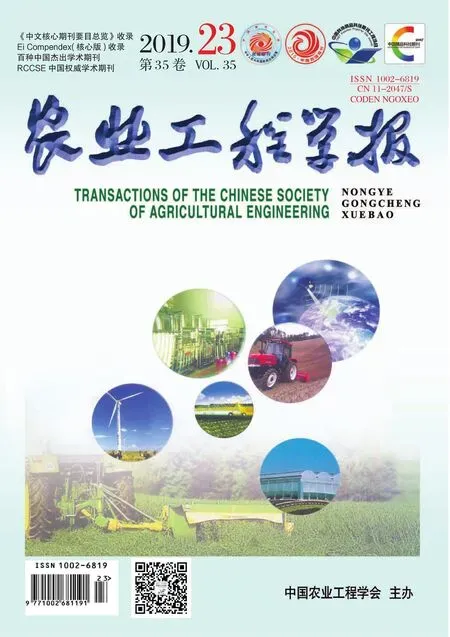日光温室装配式土质夹心墙体热湿迁移及蓄放热性能
王少杰,张广鹏,刘 鑫,吴 昆,3,刘福胜,魏 珉,胡玉秋
·农业生物环境与能源工程·
日光温室装配式土质夹心墙体热湿迁移及蓄放热性能
王少杰1,2,张广鹏1,刘 鑫1,吴 昆1,3,刘福胜1,魏 珉2,胡玉秋1
(1. 山东农业大学水利土木工程学院,泰安 271018;2. 山东农业大学园艺科学与工程学院,泰安 271018;3. 山东交通职业学院,潍坊 261206)
为研究日光温室装配式土质夹心墙体的热湿迁移及蓄放热性能,通过可控式墙体热湿耦合试验台控制墙体两侧温度、相对湿度的不同,实测墙内温度、相对湿度的稳态分布及瞬态变化,并对墙体的蓄放热性能进行定量计算与分析。结果表明:该层状异质结构复合墙体,热湿迁移存在耦合但并不明显;墙内填土始终保持高湿状态,有利于墙体蓄放热,是该墙体的主要蓄放热体;外侧墙板保温隔热效能明显,室外环境变化对墙体保温蓄热性能影响较小,且能使墙内热量主要向室内单向释放;墙内热量释放存在滞后效应,最长可持续6 d+6.5 h,但以快速放热期(4 d+8 h内)所释放热量为主,约占总放热量的85.64%~91.21%;所建立的数值分析方法可为不同厚度的同类墙体设计与建造提供参考,具有指导生产意义。该新型墙体设计理念先进,蓄放热性能优越,且能够快速装配、重复利用、就地还田,适于在中国大面积推广应用。
日光温室;墙体;温度;土质夹心;热湿迁移;蓄放热性能;装配式墙体
0 引 言
日光温室是中国独有的一种温室类型,其通过后墙吸收太阳能实现蓄放热,维持棚内温度以满足蔬菜作物生长,能有效解决中国北方地区冬季果蔬供应问题[1-4]。当前,中国日光温室墙体仍以就地取材、成本低廉、保温蓄热性能良好的土墙为主,但由于墙体稳定和蓄热保温的需要,土墙普遍较厚且易坍塌,土地利用效率低,施工缓慢且受季节性影响。研究表明,一般日光温室墙体应具有保温和储放热2种功能,随着技术发展,采用聚苯乙烯板材或型砖作为墙体室外侧保温层、使用土壤作为墙体室内侧蓄热层的新型复合墙体在实际生产中已经得到了推广和应用[5],但其保温蓄热层特别是建造方式仍无法满足工业化建造、多次重复利用的现实技术需求。为解决上述不足,研发了装配式土质夹心异质复合墙体[6],该墙体以轻质节能保温板为墙体室外侧保温层,以土和普通钢筋混凝土板为蓄热层,同时内外两侧墙板通过筋材或立柱进行连接,提高其结构稳定性与抗灾能力,土质夹心层厚度可根据不同作物对温度的不同需求灵活调整,外侧保温板可有效阻隔热量传递。该类型墙体施工建造方便快捷,蓄放热性能优越,内外墙板可重复利用,内部夹心土可原位还田,综合性能优越,有关技术已在山东烟台、潍坊、临沂等地区日光温室建造时推广和应用。
围绕层状异质复合墙体及单一材质墙体的热湿迁移及蓄放热性能,在现场试验方面,史宇亮等[7-8]研究表明土墙白天蓄积热量的43%用于改善夜间温室内的热环境;武国峰等[9]计算分析了3种不同墙体结构日光温室各组成元素的热工性能,结果表明土质墙体在保温蓄热方面优于秸秆块墙体;陈超等[10]研究了制作方式对日光温室蓄热材料热性能的影响。国内学者还通过数值分析方法对墙体热工性能进行了研究[5,11-17],其中,李明等[5]计算得到土墙蓄热层厚度为38.5 cm,佟国红等[17]对比分析了复合墙和土墙保温蓄热能力的差异。上述研究表明日光温室复合墙体具有更好的蓄放热性能,仅通过增加墙体厚度提高蓄热效率非常有限[18],其建造应向轻量化、现代化、标准化、工业化方向发展[19-24]。对异质复合墙体的热湿性能研究还表明,湿迁移会影响墙体保温蓄热能力,热迁移影响湿迁移进而改变墙体热工性能[25-28]。与现场试验、数值模拟相比,室内模型试验能通过精准调控室内热湿环境,深入系统研究墙体的热湿迁移及蓄放热性能,尤其是有利于揭示墙内填土对温度变化响应存在的滞后效应[29],该领域的研究相对较少且十分必要。
本文以自主研发的可控式墙体热湿耦合试验台[30]为基础,通过试验和理论方法系统研究日光温室装配式土质夹心墙体的热湿迁移及蓄放热性能;在试验研究基础上,修正建立该层状异质复合墙体的热工性能数值分析方法,旨在为不同土质夹心层厚度的同类型墙体提供蓄放热性能计算方法,为该新型墙体推广应用提供技术依托。
1 试验概况
1.1 试验墙体
试验墙体系层状异质复合墙,室内模型试验段长1.2 m、高0.6 m,总厚度600 mm,示意图如图1所示。其中,室外侧采用山东和悦生态新材料科技有限责任公司生产的装配式CF蒸压瓷粉加气混凝土板,厚100 mm,具有优良的保温隔热特性,能有效阻止室内侧热量向外侧传输;墙内填土采用泰安当地耕地用土夯实,厚440 mm,就地取材,蓄热放热性能好;室内侧采用60 mm厚普通钢筋混凝土板,能在有效支挡墙内填土的同时,因导热系数大能快速传热。为保证试验过程中热量在墙体中一维传递,以避免边际效应,在墙体上下左右四周均采用聚苯保温板(对应的热阻为10.26 ℃/W)进行封装,试验墙体对应的实测热阻为3.53 ℃/W,热阻值前者远大于后者能实现热量在墙体中一维传递。试验墙体所用材料对应的各项参数详见表1。
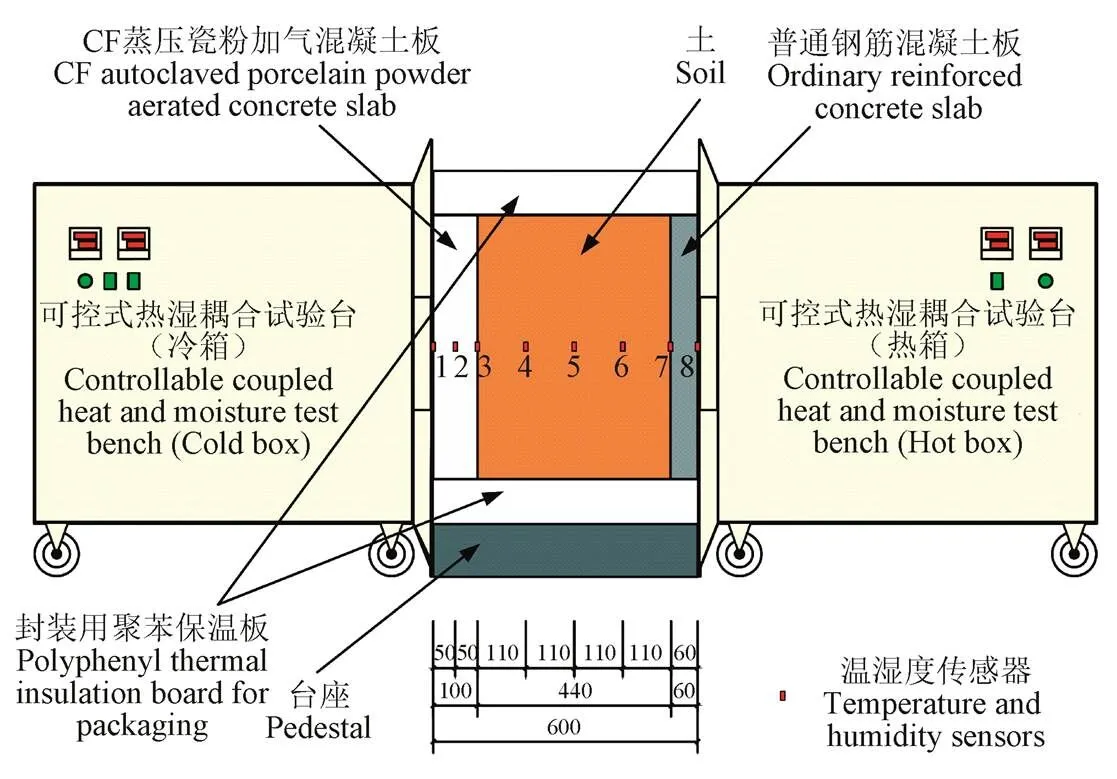
图1 试验墙体及测点布置示意图

表1 试验墙体所用材料各项参数
注:填土质量含水率为13.14%,对应最佳含水率。
Note: The fill water quality moisture content is 13.14%, corresponding to the optimum moisture content.
1.2 试验仪器
通过课题组研发的可控式墙体热湿耦合试验台调控墙体两侧温湿度,如图2所示。该试验台主要由2个可控式恒温恒湿箱组成,用于模拟实际环境的温湿度工况,提供试验要求的温湿度环境,当将箱体开敞一侧与墙体密封时,温度值可以设定在10~100 ℃,偏差不超过±0.5 ℃;相对湿度值可以设定在30%~95%,偏差值不超过±2%。数据采集采用上海搜博实业有限公司生产的SLHT1温湿度传感器、SM1210B温湿度采集模块及SV3000环境状态监测系统。
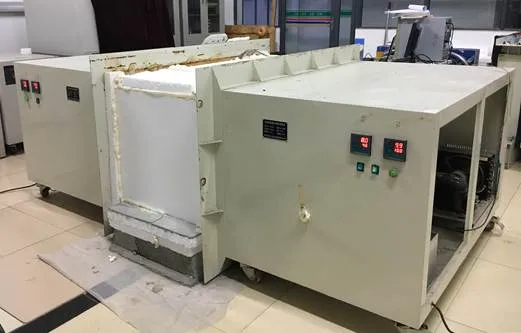
图2 墙体试验
1.3 测点布置
为得到墙体内部温度、相对湿度的稳态分布和动态迁移情况,在墙体内部共布设8个温湿度测点,如图1所示,8个测点在空间上形成一条沿墙体厚度方向的水平直线。其中,1、2、3号测点沿CF蒸压瓷粉加气混凝土板厚度方向按间距为50 mm等分布设于板的两侧和中点处;4、5、6号测点沿墙内填土厚度方向按间距为110 mm等分布设;7、8号测点沿室内侧普通钢筋混凝土板厚度方向分别布设于板两侧,所有测点沿长度、高度方向均布设于中心位置。数据采样时间间隔为5 min。
1.4 工况设计
为研究墙体两侧温度、相对湿度变化对墙体热湿迁移及蓄放热性能的影响,综合考虑日光温室室内外实际对应的热湿环境和试验台的技术参数,设计2个试验组共7种工况(表2),每种工况以墙体内温度、相对湿度达到相对稳定并维持12 h以上,由此进入下一工况。

表2 试验组列表
为研究日光温室内部温度变化对墙体热湿性能的影响,试验组1设置为室外侧温度、相对湿度不变,室内侧相对湿度不变、温度以5 ℃为梯度由30 ℃降至15 ℃,分别对应工况1-1至工况1-4;为研究室外侧温度、相对湿度变化对墙体热湿性能的影响,以工况1-2为基准,设置试验组2开展对比试验,其中,工况2-1为室外侧温度不变、相对湿度变化;工况2-2为室外侧温度变化、相对湿度不变;工况2-3为室外侧温度、相对湿度均变化。
2 结果与分析
2.1 室内温度变化时墙体的热湿性能
2.1.1 墙体温度及相对湿度稳态分布
试验组1各工况对应的所有测点温度、相对湿度达到稳定后,取稳定后12 h内的平均值作为各测点的温度、相对湿度值,以测点1对应位置为横轴坐标0点作图,试验组1各工况对应的温度、相对湿度沿墙厚度方向的分布分别如图3、图4所示。

注:数字为各测点的对应代码,下同,以墙室外表面为“0”点。
由图3可知,试验组各工况对应温度均由室内高温侧(600 mm)向室外低温侧(0 mm)传递,普通钢筋混凝土板对热量的阻隔作用较小,可实现室内与墙内热量的快速交换;墙内填土能在有效阻碍热量向外传递的同时蓄集热量,室内温度越高、对应温度梯降越大;各工况中1、3号测点温差均较大,即CF蒸压瓷粉加气混凝土板可有效阻碍墙内热量向外部的传递,保温隔热作用明显。
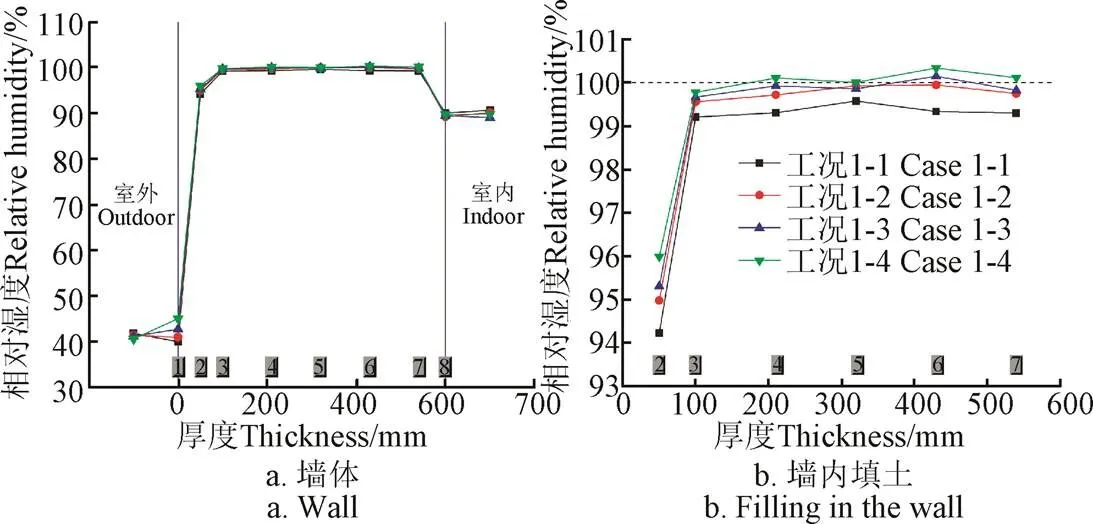
图4 试验组1相对湿度-墙厚曲线
由图4可知,各工况墙内填土均处于高湿状态(测点3~6的相对湿度维持在99%以上),基本不向两侧传递,室内温度变化对墙内湿度的影响亦较小,基本规律是伴随室内温度的降低墙内湿度略有增加。分析可知,墙内填土处于高湿状态下,相比于干燥状态的传统土墙,含湿量大的土传热介质以土和水为主导,从而具有较大的比热容与导热系数,使得热收益增加、蓄热循环周期缩短[31],即该特性更有利于墙体在白天吸收太阳辐射蓄集更多的热量,从而可在夜间或连阴天向温室内释放更多的热量,对日光温室内热环境的营造是有利的。
2.1.2 墙体温度瞬态迁移规律
1)温度变化率
为获得各测点的温度有效下降时间,以1 h为间隔求出温度下降过程中各测点的温度变化率,具体方法为:以墙内夹心土层对应的中点即测点5为例,对其温度变化曲线求导得到测点5的温度变化率曲线,对应温度及温度变化率曲线如图5所示,温度变化率大于0为升温、小于0为降温,当温度趋于相对稳定时温度变化率会在0值处上下波动,找出温度变化率此时对应的时间点,即为温度保持相对稳定的时间点,并将该点标示在对应的温度—时间曲线上,该段时间即为测点的温度有效下降时间。依据该方法可以在试验组1各工况对应的温度—时间曲线上厘清各测点在各工况的温度变化开始及结束点,如图6所示;定量结果汇总见表3。实测结果表明,由于墙体内部测点存在温度滞后效应,故定义以温度率先达到稳定态的测点8所需要的时间为快速放热期。

图5 测点5各阶段温度变化及其温度变化率

图6 试验组1各测点温度-时间曲线

表3 各阶段各测点温度有效下降时间及下降幅度
注:测点1受室外侧温度(维持在10 ℃上下)影响较大,且温度变化不大,故未列入表中。
Note: Measurement point 1 is greatly affected by the outdoor side temperature (maintained at 10 ℃), and the temperature does not change much, so it is not listed in the table.
2)空间迁移规律
分析图6可知,空间上沿墙体厚度方向,各阶段各测点温度有效下降时间由墙体内侧至外侧依次变长;温度下降开始时间率先从墙内侧开始,越靠近外侧温度开始下降的时间越晚,导致这种现象的原因是墙内填土对温度变化的响应存在滞后效应,内侧普通钢筋混凝土板较外侧CF蒸压瓷粉加气混凝土板具有更高的热扩散率。热扩散率是指在一定的热量得失情况下,物体温度变化快慢的一个物理量,相当于物体的蓄热能力,是一个在非稳态导热过程中非常重要的参数。物体的热扩散率越大,表明热量由物体表面向深层或者由深层向物体表面扩散的能力越强,普通钢筋混凝土板、CF蒸压瓷粉加气混凝土板对应的热扩散率分别为2.101×10-7、0.499×10-7m2/s。
3)时间迁移规律
为便于分析,以试验组1对应4个工况为界,将温度-时间曲线分为3个阶段,如图6所示标注。从时间角度可明显看出,各测点温度达到相对稳定所用的时间在第1阶段(室内外温差为20 ℃)最短,第2阶段(室内外温差为15 ℃)次之,第3阶段(室内外温差为10 ℃)最长。其原因是墙体两侧温差越大,墙体材料的热传导就越快,温度达到相对平衡的速度就越快,单位时间热量损失的越大,从而达到温度相对稳定的时间也就越快,这一特性有利于极端天气下室内气温骤降时墙体向室内快速释放热量,减小室内温度下降幅度。
更进一步的由图6和表3综合量化分析可知,由测点5至测点8,即室内侧280 mm厚的墙体在3 d+11 h至4 d+15.5 h内温度达到相对稳定,且下降幅度较大;靠近墙外侧厚320 mm的墙体最晚可在6 d+6.5 h后达到相对稳定。即在连续阴天,当日光温室内部气温下降时,墙内侧厚280 mm的墙体可持续在4 d+15.5 h内快速向室内释放热量,墙外侧厚320 mm的墙体最大可持续6 d+6.5 h向室内释放热量,但温度变化幅度缩小即放热能力较快速放热期减弱。
2.2 室外温湿度变化时墙体的热湿性能
对比试验组2各工况与工况1-2,可知室外温湿度变化时墙体热湿性能迁移规律,如图7所示。对比工况1-2与2-1,即当室外相对湿度增大时,试验组2-1中靠近室外侧的测点1~3的温度明显低于工况1-2,而测点4~8的温度基本相同;室外侧相对湿度的提高导致测点1相对湿度增加,进而使导热系数变大,降低该处保温性能,使测点1~3处温度下降明显,而对墙内填土及室内侧影响不大。对比工况1-2与2-2,可明显看出室外侧温度提高对墙体相对湿度影响不大,对墙体的温度影响较大,测点1~8温度均有所提升,但越靠近室内侧温度变化越小,以测点1的温度所受影响最大。对比工况1-2与2-3,即当室外侧温度、相对湿度同时提高时,首先室外侧温度的升高使墙内温度整体提高,但由于室外相对湿度提高使靠近室外的测点1~3温度提升幅度较工况2-2低,该段曲线形状更接近于工况2-1;上述现象说明无论室外高温或低温,室外高湿环境都会降低室外侧210 mm厚墙体的温度,但影响深度有限。
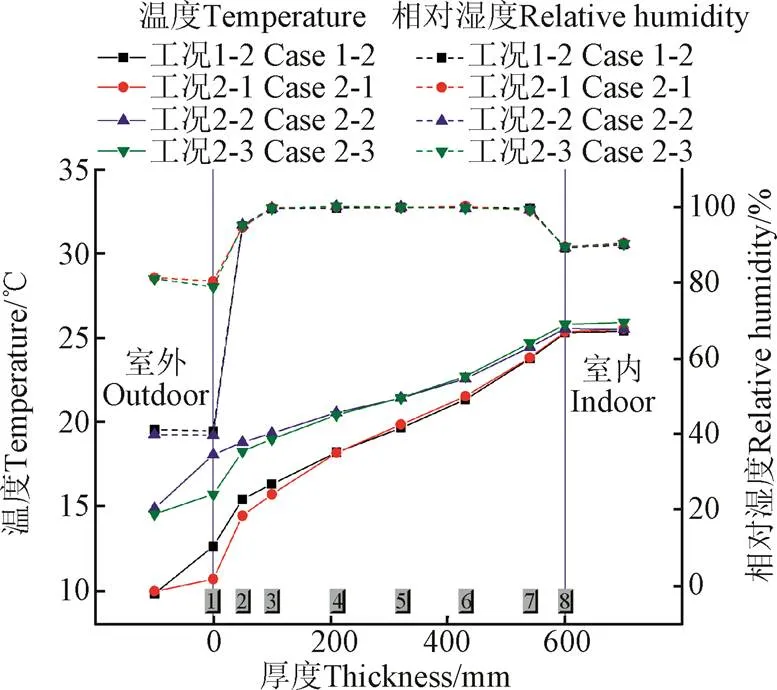
图7 室外温湿度变化时墙体的热湿性能
2.3 墙体蓄热、放热性能分析
2.3.1 墙体蓄、放热量计算
墙体蓄集、释放热量的过程是墙体内能增加、减少的过程,可以通过墙体内温度的变化计算得到蓄、放热量。物体热量与温度的换算公式为
=D(1)
式中D为物体的温度变化值,℃;为物体所吸收或释放的热量(D为正值时表示吸收热量、为负值时表示释放热量),kJ;为物体比热容,kJ/(kg·℃);为物体质量,kg。
装配式土质夹心墙体为层状异质复合墙体,水平方向由3种不同材料组成,其比热容各不相同,根据试验测点沿墙厚方向的分布,以测点1~8对应的在墙厚方向上的距离将墙体离散为7层,每一层墙体可以看作是稳态导热,其传热过程可认为是沿墙体厚度方向的一维稳态导热[11],第层墙体的蓄、放热量计算公式为



墙体整体蓄、放热量计算公式为


2.3.2 室内温度变化时墙体的蓄放热性能
由公式(2)~(4)计算可知试验组1各工况墙体各层的蓄、放热量,如图8所示。分析可知,墙体主要蓄、放热体为墙内填土,且越靠近室内一侧蓄集的热量越多,各工况及工况间各阶段墙内填土平均蓄、放热占比分别为75.81%、75.38%;室内侧普通钢筋混凝土板次之,各工况及工况间各阶段平均蓄、放热占比分别为21.92%、21.90%;室外侧CF蒸压瓷粉加气混凝土板蓄放热量最小,主要起隔热作用,这对墙体向室内侧单向释放热量是有利的。
由公式(2)~(5)计算比较了试验组1各工况所有测点温度相对稳定时墙体的蓄热量和对应各阶段快速放热期结束时以及各阶段结束时墙体的放热量,如图9所示。由图9可明显看出,各阶段放热率随着墙体两侧温差的减小不断提高,第1阶段结束时放热量占工况1-1稳定时蓄热量的26.57%,第2阶段结束时放热量占工况1-2稳定时蓄热量的29.97%,第3阶段结束时放热量占工况1-3稳定时蓄热量的60.62%。快速放热期所释放热量占各阶段放热量的绝大比例,其中第1、第2、第3阶段快速放热期所释放的热量分别占总放热量的88.64%、85.64%和91.21%,用时分别是3 d+11 h、3 d+16 h和4 d+ 8 h(见表3),即伴随墙体两侧温差减小,快速放热期的时长、放热率均提高。
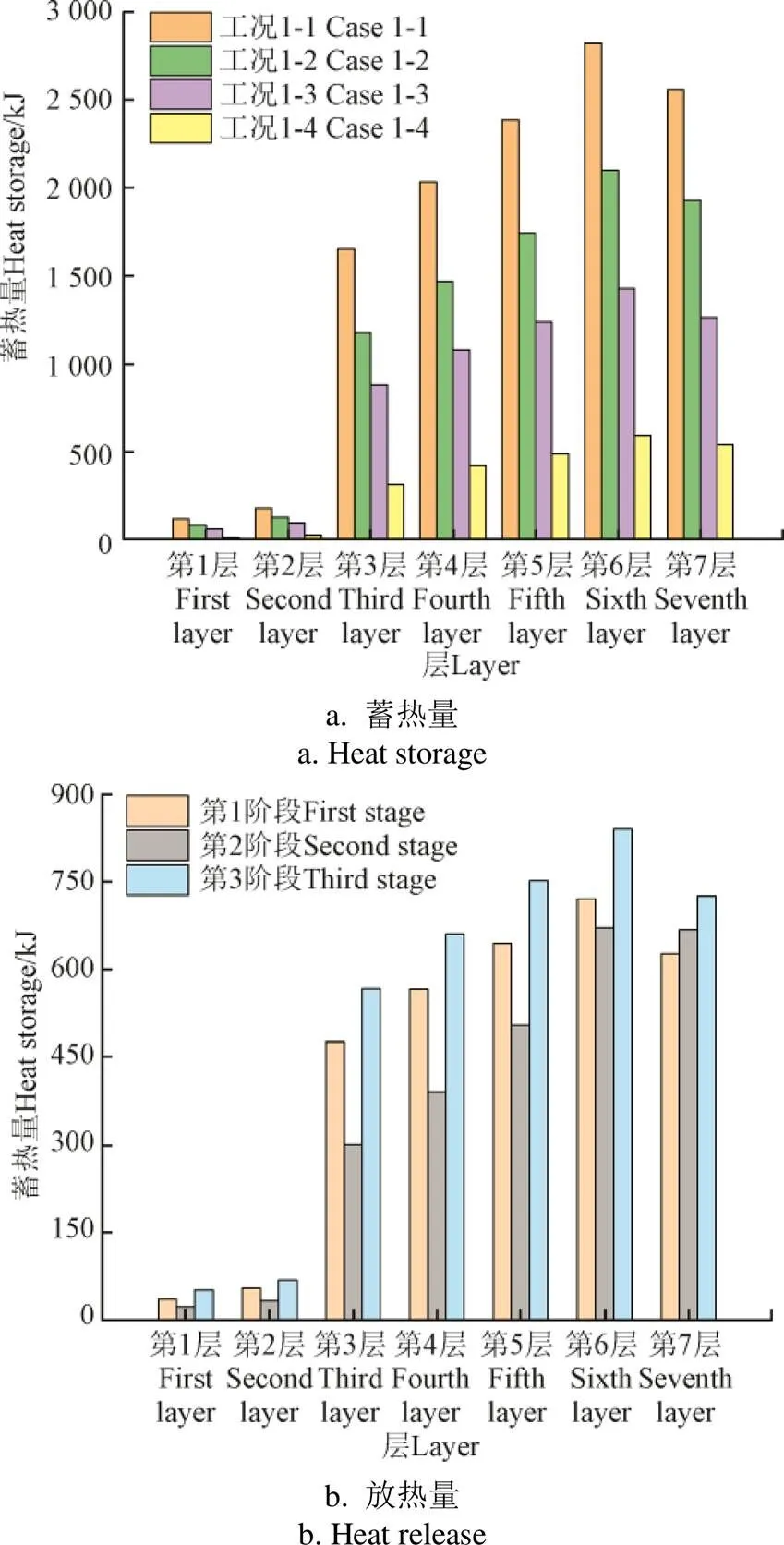
图8 试验组1各层蓄放热量

图9 试验组1各时期墙体蓄放热量
2.3.3 室外温湿度变化时墙体的蓄放热性能
计算试验组2各工况墙体各层蓄热量并求得与对比工况1-2的热量变化值,如图10所示。分析图10可知,当室外相对湿度提高时(工况2-1),墙体第1~3层蓄热量下降。由工况2-2、工况2-3的热量变化均为正值可知,由于室外侧温度提高,使墙体温度升高,墙体内能增加而蓄集更多热量;对比工况1-2与工况2-1、工况2-2与工况2-3可明显看出,墙体外侧相对湿度提高使墙体第1~3层热量流失、而第4~7层热量并无明显变化,结合2.2节的分析可知,室外相对湿度提高不仅降低了室外侧210 mm厚墙体的蓄热性能,而且使热量由墙内向室外侧单向流失,即可以通过进一步提高外侧墙板的热阻和防水性能改善墙体热环境。
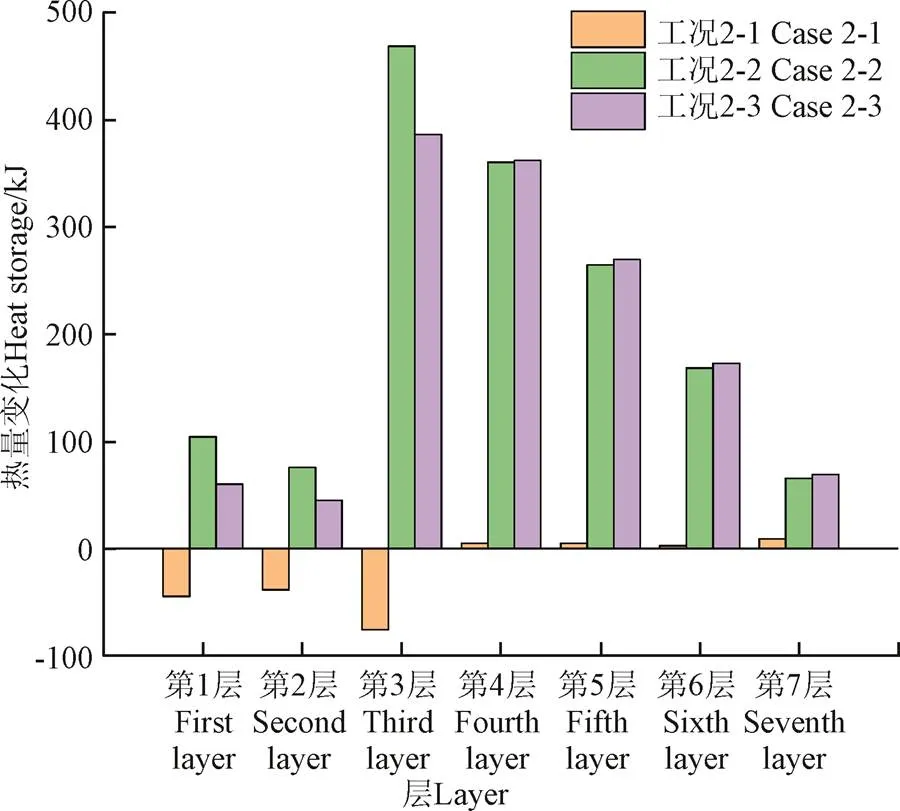
图10 试验组2与工况1-2各层蓄热量变化值
3 数值分析方法
3.1 数值建模
通过有限元软件ANSYS和APDL参数化语言,采用2维4节点热分析单元PIANE55建立装配式土质夹心墙体的数值模型,对普通钢筋混凝土板、墙内填土、CF蒸压瓷粉加气混凝土板分别赋予不同的建模参数(表1),网格尺寸为10 mm,采用热分析第一类边界条件,即物体边界上温度已知且为定值,对室内外两侧施加温度荷载并提取试验测点对应路径上的温度,通过数值分析方法研究墙体热工性能。试验实测结果表明土的相对湿度始终处于高湿状态(99%以上),且相对十分稳定,对导热系数的变化无明显影响;故为了建立简单实用高效的数值分析方法,本文在进行数值模拟时考虑了相对湿度的影响但没有考虑相对湿度变化的影响,所采用的导热系数为土在高湿状态下对应的导热系数。
3.2 试验验证
选取具有代表性的工况1-2、2-1,开展数值计算与实测结果的对比分析,如图11所示。
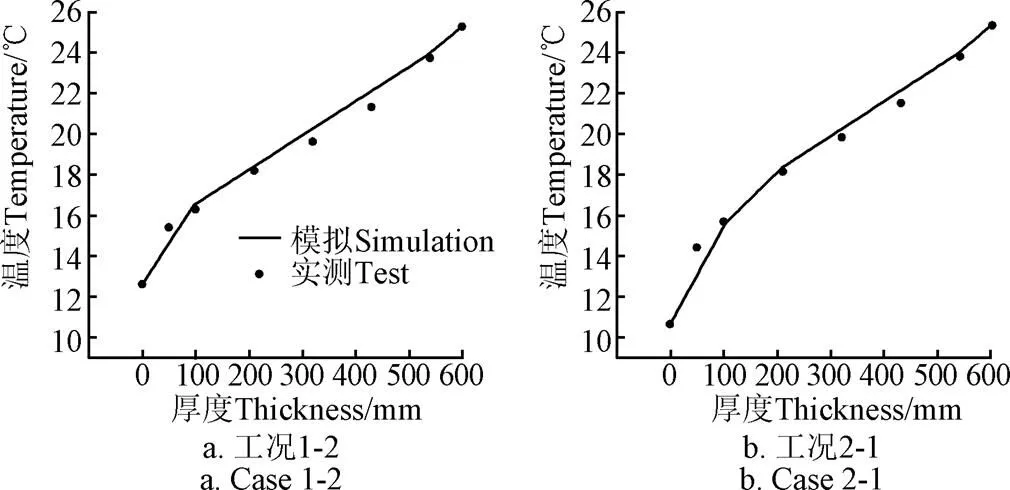
图11 模拟与实测温度对比图
可明显看出,各测点温度实测值均较为均匀的分布在模拟曲线两侧,且数值计算结果与实测结果变化趋势一致,均由高温侧传向低温侧,模拟曲线的斜率变化体现为墙体各材料的不同;定量分析表明,各测点除工况2-1中测点2误差为1.34 ℃以外,其他各测点的误差均在1.00 ℃以内,数值计算与实测结果的良好吻合为后续定量研究土质夹心层厚度不同的同类型墙体的热工性能提供了高效方法。
4 讨 论
日光温室是农业生产中应用最广泛的果蔬园艺设施之一,其墙体是日光温室的主要蓄放热体,本研究结合实际生产需求,以最新研发的日光温室装配式土质夹心墙体为研究对象,在材料选择与结构布置上以普通钢筋混凝土板和具有一定水分的土为蓄热材料,以CF蒸压瓷粉加气混凝土板为室外侧隔热保温材料,试验结果表明该设计理念可行且有利于营造、维持温室内的温度。本文所研究墙体适于中国北方地区种植草莓、葡萄等,尤以种植草莓可赶上春节茬口上市,经济效益十分明显。为兼顾墙体的保温蓄放热能力与快速建造、节约土地资源,本文墙厚为600 mm,墙内填土为440 mm,若要进一步满足对室内热量要求较高的果蔬生长,广泛使用的方法为增加墙体厚度,但目前研究表明仅通过增加温室墙体厚度来提高墙体保温蓄热效果非常有限,且墙体的热量释放路径并非一维单向传递,后续可在提高单位土体蓄热量、采取墙体外保温措施、优化墙体热量传递路径等方面开展研究。
不同于现场测试,本文通过控制变量的方法,研究了墙体两侧温度、相对湿度对墙体热湿迁移的影响,墙体不受雨、雪、风、光照及棚内作物、土壤等因素影响,得到了墙体在工况所设环境下最终稳定时的温湿度分布情况及迁移过程;同时工况设置未模拟昼夜循环情况下的温度,后续研究在考虑墙体保温蓄热性能影响因素的同时,宜加强昼夜温度变化对墙内温度波动影响的研究。
本文试验数据主要采集了温度与相对湿度,较准确地获得了墙内的热湿分布与迁移变化情况,对于墙体蓄、放热量的计算与评价主要以理论推导为主,试验结果与数值模拟结果表明墙内有关墙体保温蓄热性能的参数(如导热系数等)并非固定不变,会因墙体两侧温湿度环境的变化而受到不同程度影响,鉴于墙体保温蓄热性能影响因素的复杂性,如何实时监测、获得墙体各项热工性能参数,更加准确计算墙体蓄、放热量,后续研究应予以加强。
5 结 论
1)日光温室装配式土质夹心墙体热湿迁移存在耦合,但并不明显;墙内填土始终保持高湿状态,有利于墙体蓄热和放热;室外环境变化对墙体保温蓄热性能影响有限,其中室外相对湿度变化仅会使室外侧210 mm厚墙体的温度产生变化。
2)日光温室装配式土质夹心墙体主要蓄放热体为墙内填土,室内侧普通钢筋混凝土板次之;CF蒸压瓷粉加气混凝土板则主要起保温隔热作用,能使墙内热量主要向室内单向释放。室内侧280 mm厚墙体对室内温度变化响应迅速且可在4 d+15.5 h内持续向室内释放热量;墙体在快速放热期4 d+8 h内所释放热量占总放热量的85.64%~91.21%。
3)日光温室装配式土质夹心墙体具有优良的保温蓄热性能,墙内热湿迁移对墙体蓄放热为有利影响,对室外环境变化有一定抵御能力。该新型层状异质结构复合墙体符合室外侧为保温隔热层、内侧为蓄放热层的设计理念,且实现了快速装配、节能环保,具有一定推广价值。数值分析方法与实测结果吻合良好,可为不同地区不同作物所需不同蓄放热量日光温室墙体的设计与建造提供参考,具有指导生产意义。
[1]李天来. 我国日光温室产业发展现状与前景[J]. 沈阳农业大学学报,2005,36(2):131-138.
Li Tianlai. Current situation and prospects of greenhouse industry development in China[J]. Journal of Shenyang Agricultural University, 2005, 36(2): 131-138. (in Chinese with English abstract)
[2]Zhang Jian, Wang Jian, Guo Shirong, et al. Study on heat transfer characteristics of straw block wall in solar greenhouse[J]. Energy & Buildings, 2017, 139: 91-100.
[3]束胜,康云艳,王玉,等. 世界设施园艺发展概况、特点及趋势分析[J]. 中国蔬菜,2018(7):1-13.
Shu Sheng, Kang Yunyan, Wang Yu, et al. Development overview, characteristics and trend analysis of the world’s facility horticulture[J]. China Vegetables, 2018(7): 1-13. (in Chinese with English abstract)
[4]鲍恩财,曹晏飞,邹志荣,等. 节能日光温室蓄热技术研究进展[J]. 农业工程学报,2018,34(6):1-14.
Bao Encai, Cao Yanfei, Zou Zhirong, et al. Research progress of thermal storage technology in energy-saving solar greenhouse[J]. Transactions of the Chinese Society of Agricultural Engineering (Transactions of the CSAE), 2018, 34(6): 1-14. (in Chinese with English abstract)
[5]李明,周长吉,魏晓明. 日光温室墙体蓄热层厚度确定方法[J]. 农业工程学报,2015,31(2):177-183.
Li Ming, Zhou Changji, Wei Xiaoming. Thickness determination of heat storage layer of wall in solar greenhouse[J]. Transaction of the Chinese Society of Agricultural Engineering (Transactions of the CSAE), 2015, 31(2): 177-183. (in Chinese with English abstract)
[6]王少杰,杜善梁,魏珉,等. 一种预制装配式日光温室异质复合墙体:中国专利,207863216U[P]. 2018-09-14.
[7]史宇亮,王秀峰,魏珉,等. 日光温室土墙体温度变化及蓄热放热特点[J]. 农业工程学报,2016,32(22):214-221.
Shi Yuliang, Wang Xiufeng, Wei Min, et al. Temperature variation, heat storage and heat release characteristics of soil wall in solar greenhouse[J]. Transactions of the Chinese Society of Agricultural Engineering (Transactions of the CSAE), 2016, 32(22): 214-221. (in Chinese with English abstract)
[8]史宇亮,王秀峰,魏珉,等. 日光温室不同厚度土墙体蓄放热特性研究[J]. 农业机械学报,2017,48(11):359-367.
Shi Yuliang, Wang Xiufeng, Wei Min, et al. Comparison of heat storage and release characteristics of different thicknesses soil wall solar greenhouse[J]. Transactions of the Chinese Society for Agricultural Machinery, 2017, 48(11): 359-367. (in Chinese with English abstract)
[9]武国峰,黄红英,孙恩惠,等. 不同墙体结构日光温室保温效果的研究[J]. 农机化研究,2015,37(6):164-168.
Wu Guofeng, Huang Hongying, Sun Enhui, et al. Study on performance of heat preservation of solar greenhouse with different materials North wall[J]. Journal of Agricultural Mechanization Research, 2015, 37(6): 164-168. (in Chinese with English abstract)
[10]陈超,李琢,管勇,等. 制作方式对日光温室相变蓄热材料热性能的影响[J]. 农业工程学报,2012,28(增刊1):186-191.
Chen Chao, Li Zhuo, Guan Yong, et al. Effects of building methods on thermal properties of phase change heat storage composite for solar greenhouse[J]. Transactions of the Chinese Society of Agricultural Engineering (Transactions of the CSAE), 2012, 28(Supp.1): 186-191. (in Chinese with English abstract)
[11]马承伟,陆海,李睿,等. 日光温室墙体传热的一维差分模型与数值模拟[J]. 农业工程学报,2010,26(6):231-237.
Ma Chengwei, Lu Hai, Li Rui, et al. One-dimensional finite difference model and numerical simulation for heat transfer of wall in Chinese solar greenhouse[J]. Transactions of the Chinese Society of Agricultural Engineering (Transactions of the CSAE), 2010, 26(6): 231-237. (in Chinese with English abstract)
[12]佟国红,David M C. 日光温室墙体蓄放热层温度变化规律研究[J]. 农业工程学报,2019,35(7):170-177.
Tong Guohong, David M C. Temperature variations in energy storage layers in Chinese solar greenhouse walls[J]. Transactions of the Chinese Society of Agricultural Engineering (Transactions of the CSAE), 2019, 35(7): 170-177. (in Chinese with English abstract)
[13]许红军,曹晏飞,李彦荣,等. 基于CFD的日光温室墙体蓄热层厚度的确定[J]. 农业工程学报,2019,35(4):175-184.
Xu Hongjun, Cao Yanfei, Li Yanrong, et al. Determination of thickness of thermal storage layer of solar greenhouse wall based on CFD[J]. Transactions of the Chinese Society of Agricultural Engineering (Transactions of the CSAE), 2019, 35(4): 175-184. (in Chinese with English abstract)
[14]龙激波,阿勇嘎,王泉,等. 光热建筑一体化Trombe墙体系统传热性能[J]. 土木建筑与环境工程,2018,40(1):141-148.
Long Jibo, A Yongga, Wang Quan, et al. Heat transfer performance of a photo-thermal Trombe wall system integrated with building[J]. Journal of Civil, Architectural & Environmental Engineering, 2018, 40(1): 141-148. (in Chinese with English abstract)
[15]张勇,高文波,邹志荣. 日光温室主动蓄热后墙传热CFD模拟及性能试验[J]. 农业工程学报,2015,31(5):203-211.
Zhang Yong, Gao Wenbo, Zou Zhirong. Performance experiment and CFD simulation of heat exchange in solar greenhouse with active thermal storage back-wall[J]. Transactions of the Chinese Society of Agricultural Engineering (Transactions of the CSAE), 2015, 31(5): 203-211. (in Chinese with English abstract)
[16]时盼盼,吕建,孙于萍,等. 日光温室相变蓄热墙体最佳组合厚度的模拟研究[J]. 太阳能学报,2019,40(2):496-504.
Shi Panpan, Lv Jian, Sun Yuping, et al. Simulation study on optimum composite thickness of phase change heat storage wall[J]. Acta Energiae Solaris Sinica, 2019, 40(2): 496-504. (in Chinese with English abstract)
[17]佟国红,白义奎,赵荣飞,等. 日光温室复合墙与土墙热性能对比分析[J]. 沈阳农业大学学报,2011,42(6):718-722.
Tong Guohong, Bai Yikui, Zhao Rongfei, et al. Thermal property investigations for layered walls and earth walls in Chinese solar greenhouses[J]. Journal of Shenyang Agricultural University, 2011, 42(6): 718-722. (in Chinese with English abstract)
[18]管勇,陈超,凌浩恕,等. 日光温室三重结构相变蓄热墙体传热特性分析[J]. 农业工程学报,2013,29(21):166-173.
Guan Yong, Chen Chao, Ling Haoshu, et al. Analysis of heat transfer properties of three-layer wall with phase-change heat storage in solar greenhouse[J]. Transactions of the Chinese Society of Agricultural Engineering (Transactions of the CSAE), 2013, 29(21): 166-173. (in Chinese with English abstract)
[19]李天来,邹志荣,马承伟,等. 节能日光温室设计建造规程[M]. 北京:中国农业出版社,2017.
[20]杨建军,邹志荣,张智,等. 西北地区日光温室土墙厚度及其保温性的优化[J]. 农业工程学报,2009,25(8):180-185.
Yang Jianjun, Zou Zhirong, Zhang Zhi, et al. Optimization of earth wall thickness and thermal insulation property of solar greenhouse in Northwest China[J]. Transaction of the Chinese Society of Agricultural Engineering (Transactions of the CSAE), 2009, 25(8): 180-185. (in Chinese with English abstract)
[21]鲍恩财,申婷婷,张勇,等. 装配式主动蓄热墙体日光温室热性能分析[J]. 农业工程学报,2018,34(10):178-186.
Bao Encai, Shen Tingting, Zhang Yong, et al. Thermal performance analysis of assembled active heat storage wall in Chinese solar greenhouse[J]. Transactions of the Chinese Society of Agricultural Engineering (Transactions of the CSAE), 2018, 34(10): 178-186. (in Chinese with English abstract)
[22]孙周平,黄文永,李天来,等. 彩钢板保温装配式节能日光温室的温光性能[J]. 农业工程学报,2013,29(19):159-167.
Sun Zhouping, Huang Wenyong, Li Tianlai, et al. Light and temperature performance of energy-saving solar greenhouse assembled with color plate[J]. Transactions of the Chinese Society of Agricultural Engineering (Transactions of the CSAE), 2013, 29(19): 159-167. (in Chinese with English abstract)
[23]周波,张义,方慧,等. 装配加温除湿系统的轻简装配式日光温室设计及性能试验[J]. 农业工程学报,2016,32(11):226-232.
Zhou Bo, Zhang Yi, Fang Hui, et al. Performance experiment and design of simply assembled Chinese solar greenhouse equipped with heating and dehumidification system[J]. Transactions of the Chinese Society of Agricultural Engineering (Transactions of the CSAE), 2016, 32(11): 226-232. (in Chinese with English abstract)
[24]李明,周长吉,周涛,等. 日光温室土墙传热特性及轻简化路径的理论分析[J]. 农业工程学报,2016,32(3):175-181.
Li Ming, Zhou Changji, Zhou Tao, et al. Heat transfer process of soil wall in Chinese solar greenhouse and its theoretical simplification methods[J]. Transactions of the Chinese Society of Agricultural Engineering (Transactions of the CSAE), 2016, 32(3): 175-181. (in Chinese with English abstract)
[25]Hou Shaodan, Liu Fusheng, Wang Shaojie, et al. Coupled heat and moisture transfer in hollow concrete block wall filled with compressed straw bricks[J]. Energy & Buildings, 2017, 135: 74-84.
[26]Wang Yingying, Ma Chao, Liu Yanfeng, et al. Effect of moisture migration and phase change on effective thermal conductivity of porous building materials[J]. International Journal of Heat and Mass Transfer, 2018, 125: 330-342.
[27]李玮,刘芳,陈宝明. 多层墙体内部湿迁移对传热的影响[J]. 建筑科学,2017,33(8):117-122.
Li Wei, Liu Fang, Chen Baoming. Effects of moisture transfer on heat transmission of multilayer wall[J]. Building Science, 2017, 33(8): 117-122. (in Chinese with English abstract)
[28]Ferrari S, Riva A. Insulating a solid brick wall from inside: Heat and moisture transfer analysis of different options[J]. Journal of Architectural Engineering, 2019, 25(1): 04018032.
[29]Xiao Jing, Yu Fangjian, Zhu Wanying, et al. Comment on “The whole-soil carbon flux in response to warming”[J]. Science, 2018, 359: eaao0218.
[30]刘福胜,王宏斌,张顺轲,等. 可控式墙体热湿耦合试验台:203011875U[P]. 2013-06-19.
[31]William A M. Heat flow through soils and effects on thermal storage cycle in high-mass structures[J]. Journal of Aerospace Engineering, 2006, 19(1): 55-58.
Heat and moisture transfer and heat storage and release performance of assembled soil sandwich wall in solar greenhouse
Wang Shaojie1,2, Zhang Guangpeng1, Liu Xin1, Wu Kun1,3, Liu Fusheng1, Wei Min2, Hu Yuqiu1
(1.,,271018,;2.,,271018,;3.,261206,)
Solar greenhouse is a unique type of greenhouse in China. It can absorb solar energy through the back wall to achieve heat storage and release, maintain the temperature in the greenhouse to meet the growth of vegetable crops, and effectively solve the problem of winter fruit and vegetable supply in northern cold region of China. In order to solve the problems of excessive thickness, easy collapse and low land-use efficiency of traditional soil wall, an assembled heterogeneous composite soil sandwich wall was developed. Prefabricated ordinary reinforced concrete slabs and light energy-saving thermal insulation slabs were used on both sides of the wall, respectively. The thickness of the soil sandwich layer could be flexibly adjusted according to the different needs of different crops for temperature. The interior and exterior wall panels are backfilled with soil and tied with reinforcements. The exterior insulation panels can effectively prevent heat transfer. In order to deeply and systematically study the heat and moisture transfer and heat storage and release performance of assembled soil sandwich wall in solar greenhouse, and reveal the hysteretic effect of filling on the response of temperature change, indoor model tests were carried out. The test wall is 1.2 m long and 0.6 m high with a total thickness of 600 mm. CF autoclaved ceramic powder aerated concrete slab with excellent heat preservation and insulation characteristics is used outdoors with a thickness of 100 mm. The filling material in the wall is taken locally, and the cultivated land with good heat storage and heat release performance is tamped, with a thickness of 440 mm. The indoor side is made of ordinary reinforced concrete slab with a thickness of 60 mm, which is effectively supported and retained. While supporting the wall, it has high thermal conductivity and fast heat transfer. Considering the actual indoor and outdoor hygrothermal environment of solar greenhouse and the technical parameters of the self-developed controllable coupled heat and moisture test bench, two test groups were designed under seven cases. The temperature and relative humidity changes of the indoor and outdoor walls were accurately controlled by the test bench, and the temperature and humidity sensors embedded in the wall were used in advance. The data acquisition system is used to measure and analyze the steady-state distribution and transient change of temperature and relative humidity in the wall. The thermal storage and release performance of the wall is calculated and analyzed quantitatively through theoretical formula deduction. On the basis of experimental research, the numerical analysis method of thermal performance of the layered heterogeneous composite wall is revised and established. The results show that the heat and moisture transfer of the composite wall with layered heterogeneous structure is coupled but not significant; the filling in the wall keeps high humidity (more than 90%) all the time, which is conducive to the heat storage and release of the wall, and is the main heat storage and release body of the wall; the thermal insulation efficiency of the outer wall panel is remarkable, and the change of the outdoor environment affects the thermal insulation and storage performance of the wall. The heat release in the wall has a lag effect in time and space, the longest lasting time is 6 days and 6.5 hours, but the heat release in the fast exothermic period (within 4 days and 8 hours) accounts for 85.64% to 91.21% of the total heat release, and the 280 mm thick wall on the indoor side responds quickly to the change of indoor temperature. The numerical analysis method can provide reference for the design and construction of similar walls with different thickness, and has guiding significance for production. The new wall design concept is advanced. The outer wall is thermal insulation layer and the inner wall is heat storage and release layer. It has excellent heat storage and release performance, and it can be quickly assembled, reused and returned to the field in situ. It is suitable for wide application in China.
solar greenhouse; walls; temperature; soil sandwich; heat and moisture migration; heat storage and release performance; assembled wall
王少杰,张广鹏,刘 鑫,吴 昆,刘福胜,魏 珉,胡玉秋. 日光温室装配式土质夹心墙体热湿迁移及蓄放热性能 [J]. 农业工程学报,2019,35(23):209-217.doi:10.11975/j.issn.1002-6819.2019.23.026 http://www.tcsae.org
Wang Shaojie, Zhang Guangpeng, Liu Xin, Wu Kun, Liu Fusheng, Wei Min, Hu Yuqiu. Heat and moisture transfer and heat storage and release performance of assembled soil sandwich wall in solar greenhouse[J]. Transactions of the Chinese Society of Agricultural Engineering (Transactions of the CSAE), 2019, 35(23): 209-217. (in Chinese with English abstract) doi:10.11975/j.issn.1002-6819.2019.23.026 http://www.tcsae.org
2019-07-13
2019-11-06
中国博士后科学基金面上项目(2017M622239);国家大宗蔬菜产业技术体系项目(CARS-23-C04);国家重点研发计划政府间国际科技创新合作重点专项项目(2017YFE9135300、SQ2017YFNC060047)
王少杰,副教授,博士,主要从事农业建筑与结构、结构安全与防灾诊治等研究。Email:tumuwsj@sdau.edu.cn
10.11975/j.issn.1002-6819.2019.23.026
S625.1; TU111.2
A
1002-6819(2019)-23-0209-09

